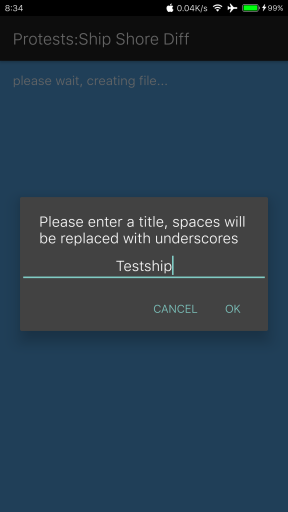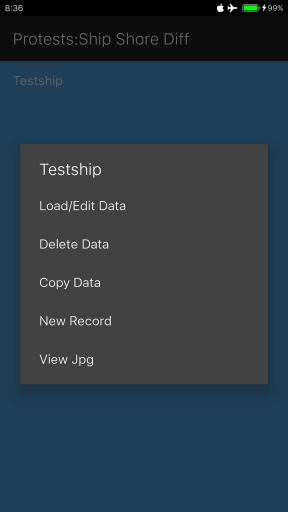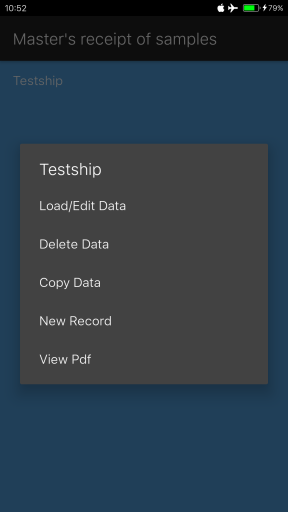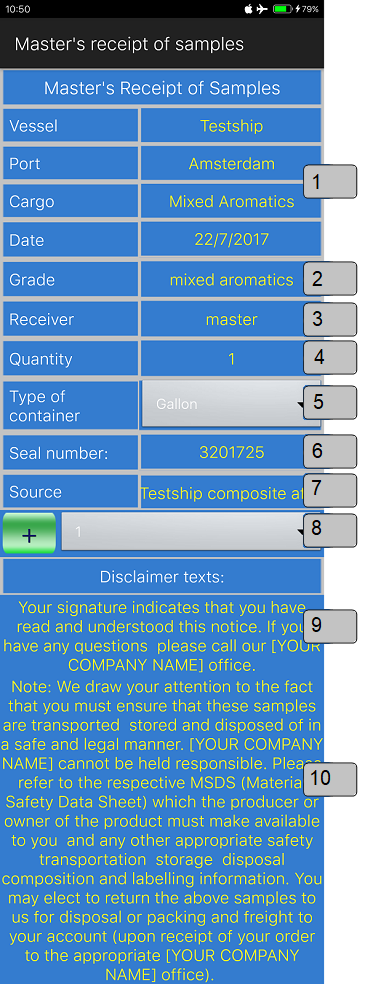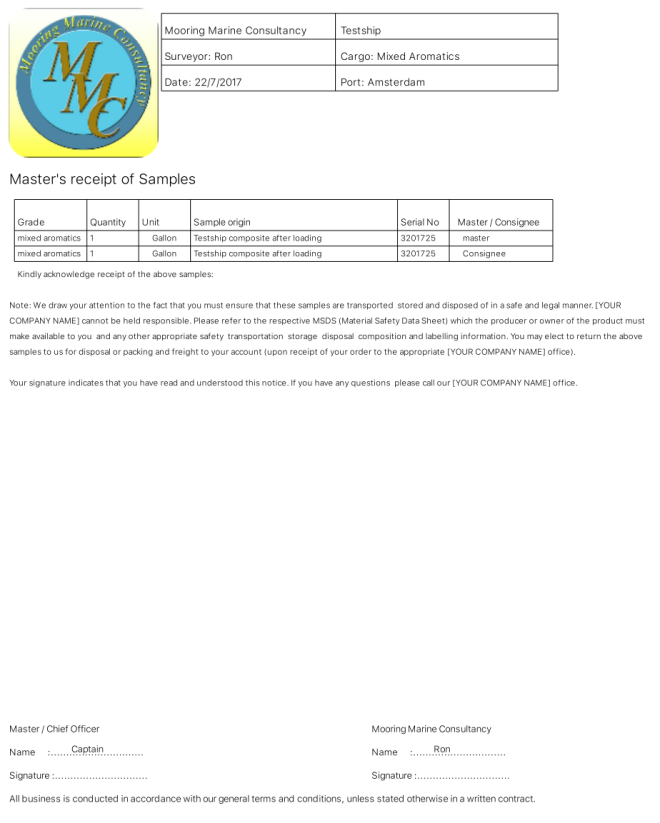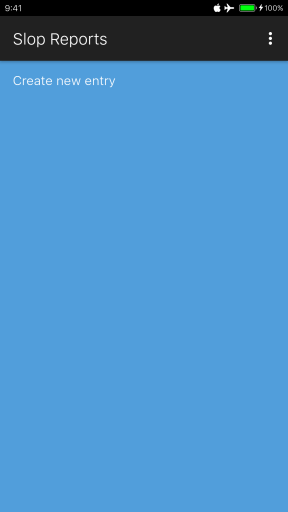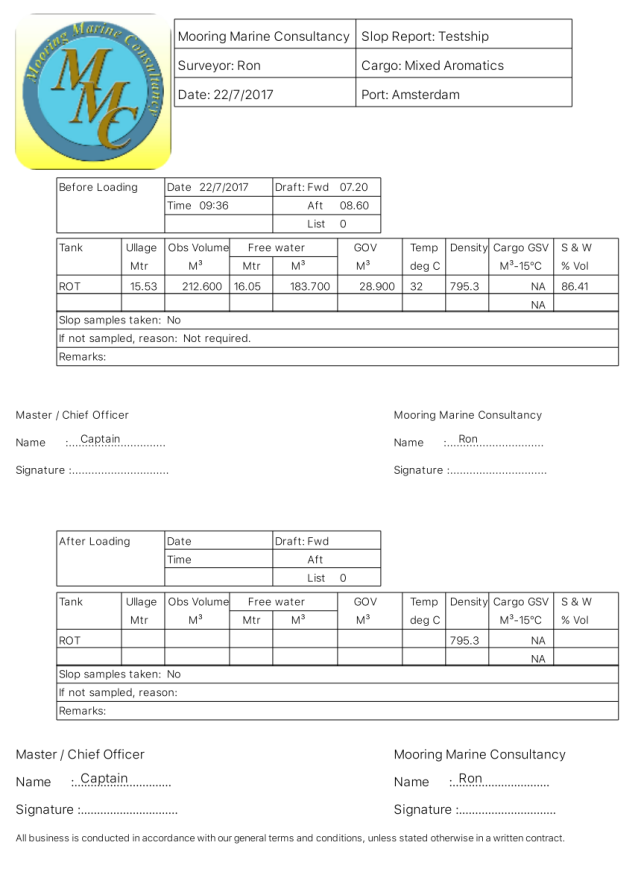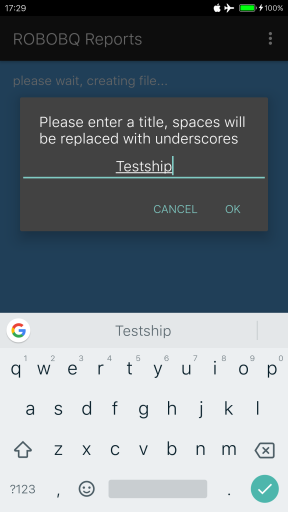As promised last week, we are starting a series of tutorials for the Android version of Cargo Surveyor.
Each tutorial will discuss specific features of the app, and explain how to go about setting up reports, what settings need attention and so on.
Part 1 of the tutorials will deal with the load port and specifically with the pre-loading report:
First thing to do is check that general settings and pdf settings in our app have been selected according to our needs:
In general settings, we select ‘SI Metric’ and ‘ASTM 2004’ since that is the standard used in most European ports:
 We will briefly discuss here all general settings:
We will briefly discuss here all general settings:
In the top half of the screen there are precision settings for VCF, GSV, MTons, LTons and Bbls/Gallons; The VCF is rounded by default based on whether the 1980 or the 2004 version of the ASTM tables have been selected, but you can also choose a rounding manually, using the dropdown on the right hand side.
When using the 1980 tables the VCF is rounded to 4 decimals (unless you override this with a number of your own choice), whereas when the 2004 tables are selected the VCF is rounded by 5 decimals.
In “Other settings’ we find the following:
– Notifications show all: this is for trouble shooting purposes and should be left unchecked normally.
– SI Metric / Imperial: this is the most important setting of all; if you select SI Metric, VCF calculations for crude will be carried out using table 54A, whereas if you select Imperial, table 6A will be used. The same goes for products (table 54B and table 6B), Luboils (table 54D and table 6D) and Special applications (table 54C and 6C).
This setting directly affects how your reports are printed: if for example you have created an ullage report using SI Metric units but wish to print it using Imperial units, then simply select Imperial when you go to pdf reports. More on this later.
– Use T52(1980) / Use T52(2004): when ASTM 1980 is selected, T52(1980) is selected and T52(2004) is disabled. When you select ASTM 2004 you have however the option to use either of them.
– Use Table 56 / Use Dens – 11: although using density – 11 points for the calculation of metric tons in air is a shortcut (Table 56 is the official approach), in some countries it seems to be preferred to use density – 11 points which is why this option is here. This option is only applicable when using SI Metric tables, regardless of whether ASTM 1980 or 2004 is used.
– ASTM 1980 / ASTM2004: whether to use the old (1980) ASTM tables or the new (2004) version of the tables. There is a significant difference in calculation method of the VCF between the two tables and while the numeral difference between the VCF calculated at either table is not all that big (depending on the density and temperature around or less than 0.0001), when dealing with large quantities the difference in quantity can amount to more than a few tons.
– Reset to default: if you press this button, all settings revert to their defaults, being:
- ASTM 1980
- SI Metric
- Use dens – 11
- VCF: 4 decimals
- MTons: 3 decimals
- LTons: 2 decimals
- Bbls/Gallons: 0 decimals
In the pdf report settings we can enter the ship’s name, arrival draft, port, date and cargo name. We can also select the activity (‘Before Loading’), and enter our Company’s legal disclaimer if we haven’t done that yet.

Pdf report settings
Let’s go through all settings one by one to clarify a few things:
– Set Logo button: If you press this button, a file browser window opens up and you can select a logo (jpg) file. The size does not really matter. The image will automatically be adjusted to fit in the image square.
– Camera: alternatively you can take a picture with the camera on your phone and use that as a logo.The logo will be printed in the upper left corner on all pdf reports. The first time that you opt to use your camera, the app will ask you for permission to access the camera.
– Company header: generally the name of your company. You should limit the amount of text to what you can see on the screen, to ensure that it fits in the header on the pdf reports.
All text fields where nothing has been entered yet, show a hint in red color; any text that has been entered by the user is in yellow.
– Surveyor: name of the surveyor.
– Master / CO: name of captain, or chief mate etc.
– Cargo name: name of the current cargo (to be loaded or discharged etc).
– Port: the current port as you wish it to appear in the report.
– Date: the date that you wish to appear on your report.
We can also enter any email addresses (or take them from the Contacts), that we wish to send our reports to.
The format of our reports will be ‘pdf’, this is the default setting on Android phones which run on Kitkat or higher.
Any text fields that are empty have a hint text shown in red color.
– Cargo Activity: the buttons ‘Before’ and ‘Loading’ let you choose between ‘before’ and ‘after’ and ‘loading’ and ‘discharging’. This setting will be reflected in the header in ullage reports. (more on that in the tutorial about ullage reports).
– Mother or daughter vessel: in case the vessel is doing an STS operation, the name of mother of daughter vessel can be entered here.
– Draft: you can enter 4 drafts: aft – forward and port – stbd. These are also used in ullage reports.
– Email recipients: you can enter a maximum of 4 email addresses that will automatically be included in reports that you send by email. You can either press the ‘Contacts’ button and choose a recipient using your contacts, or enter email addresses manually. The first time that you opt to use your contacts, the app will ask you for permission to access contacts.
– Keep ullages in original units: this will prevent ullages from being converted; if your report is using SI Metric units but the ship that you are attending only has tank tables in feet and inches, then you can enter your ullages in feet and inches while using the SI Metric setting, and your ullage report will be generated using SI Metric settings without converting the ullages into metric units.
– Preferred ullage report format: this is applicable to all reports actually. The format of our reports will be ‘pdf’, this is the default setting on Android phones which run on Kitkat or higher. When the pdf report is generated, it is automatically saved in the internal storage of the phone. If the jpg format is selected (or if the phone’s Android version is below Kitkat), the generated jpg file will be automatically saved in a directory called ‘saved_images’.
In load port:
Let us assume that the vessel (‘TestShip’) has arrived in Amsterdam for loading a cargo of Mixed Aromatics. The Vessel’s last cargo was 50 ppm Gasoline PU50, second last cargo was JET A1 and third last cargo was JET A1. All cargo tanks are full “Pure Epoxy” coated. The cleaning method was: ‘well drained’. The cargo is destined as ‘Mogas Blend Stock’.
The following reports will be required on arrival before loading:
- Pre-loading report
- OBQ report
- Slop report
- Bunker report
- VEF report
Once the ship has completed loading, the following reports are required:
- Ullage report
- Bunker report
- Slop report
- Transfer executive summary (loading)
- Sampling report
- Master’s receipt of samples report
- Time sheet
- Ref heights / raw measurements report
- Any NOADs / SOF as required
Pre-loading Report:

Using the Pre-Cargo Matrix we can first establish whether the ship’s tanks are suitable for loading the nominated cargo basis the tank cleaning requirements and actual tank cleaning done. You can find the Pre-Cargo Matrix utility in the very first screen of the app; when you press the options menu (on newer phones this is the three vertical dots on the upper right hand corner of the screen), you will find it there.
Using the pre-cargo matrix module, we select ‘UN1203 50 ppm – Gasoline PU50, SU50 ULG’ as the ‘From’ entry, and ‘UN3295, Platformate Reformaten Mogas or Chem’ as the ‘To’ entry.
As can be seen in the screenshot on the left, the next cargo is NC (not compatible) if the cargo is destined to be Chemical Feed Stock, but if destined as Mogas Blend Stock it is compatible, provided that the cargo tanks are well drained as defined in the definition shown below the compatibility field.
It is also stated here that any ROB volume in excess of 0.05% of the individual tank capacity does not meet the well drained criteria.
Next step is to carry out the tank inspection to verify that tanks, pump columns and pipe lines are well drained. The pre-loading report will be compiled on the basis of the findings in the course of the tank inspection.
Upon completion of the tank inspection we have concluded that all tanks and lines have been well drained, and we can therefore mark all cargo tanks using the appropriate letter (A in this case).
Any tanks that would have failed the inspection would have been marked ‘X’, and this will have resulted in a remark appearing in the pre-loading report stating that ‘the following tanks were found to be unsuitable for loading:’.
To get to the Pre-loading report editor we first need to go to the list of reports (‘Pdf/jpg Reports’), which can be accessed by pressing the options menu button (on newer phones this in the top right hand corner of the screen); this options menu is available from within:
- the first screen when you open the app
- the tank configuration screen for standard layout
- the tank configuration screen for extended layout
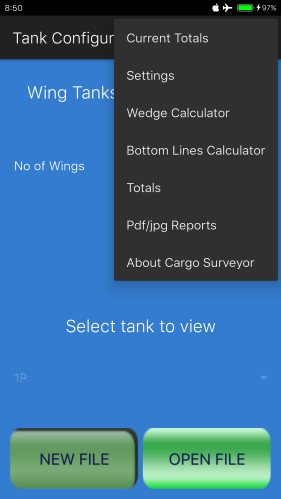
After pressing the option ‘Pdf/jpg Reports’, the list of available types of reports appears. If you accessed this from the very first screen, a message comes up first, asking you to confirm whether to use standard or extended layout for ullage reports. For Pre-loading reports you can choose either, it makes no difference. The choice between extended and standard layout is only important for ullage reports and transfer summary reports:


After selecting ‘EXTENDED’ or ‘STANDARD’ (if applicable), from the list above you select ‘Pre-loading reports’, and this will bring you to the list of available Pre-loading reports. If this is the first time that you are going to create a Pre-loading report, the list will show only one entry: ‘Create new entry’:
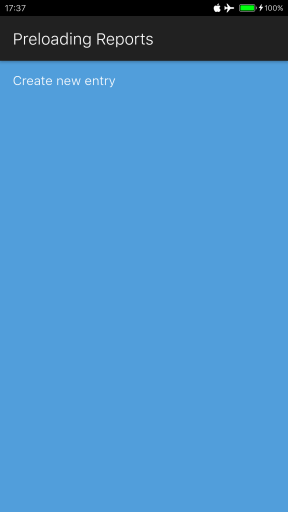
After pressing the ‘Create new entry’ line in the list, you will be asked to enter a title for the report, we can simply use our ‘Testship’ as title:
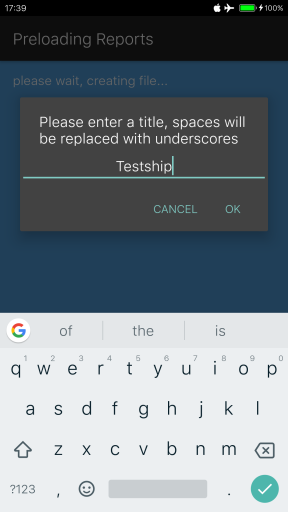
Once you press ‘OK’, the Pre-loading reports list shows the new entry ‘Testship’. The here described process for accessing the pdf/jpg reports, and for creating a new pdf/jpg report is the same for all the reports except for the ullage report and transfer report; the ullage report is created from within the STANDARD and EXTENDED tank layout. The transfer report is created based on the selection of two existing ullage reports. More on this in future tutorials.
Now if you select the ‘Testship’ entry, the Pre-loading reports editor appears if you select ‘Load/Edit data’ from the list of available actions:


In order to complete the Pre-loading report we have to fill in the time of completion of the inspection, the cargo tank history and the method of cleaning used for each tank.
Once we have created a new report (with the name ‘Testship’ for example), the screen will open with just one tank named ‘1’. We enter ‘1P’ for the tank number, and fill in the name of the cargo to load, the last cargo and the 2nd last / 3rd last cargo, as well as the coating in this tank.
The default selected cleaning method is always ‘A’ (tanks lines etc completely drained), and since this is the method used on ‘Testship’ we will leave it like that.
We can also select ‘Yes’ for ‘Inert Gas In Operation’, and ‘Vapor locks’, while ‘IG released for inspection’ remains ‘No’.
Now we press the ‘+’ button to create a new entry. You will notice that the information under cargo tank history has been copied to the new tank, for convenience purposes. If the tank has a different history, or a different cargo to load etc, all we need to do is update the applicable fields.
The only thing we need to do now is change the tank name to ‘2P’, then press the ‘+’ button again to create a new tank etc, until we have completed the entries for all tanks (in this case ‘Testship’ has 6 pairs of wing tanks plus 2 slop tanks).
Once we are done we can return to the list of preloading reports, press our newly created report ‘Testship’ and select ‘View pdf’ (or ‘View jpg’, if your phone is not capable of generating pdf files).
After pressing the back button, the app will ask if you wish to send the report by email and it will also ask if you wish to export the file to csv, and if you wish to send the csv by email if you opt to export.
If you press ‘View pdf’ again in future, the app will ask you if you wish to overwrite the file, since it exists already.
You can see an example of the pre-loading report below:


The below picture shows page 2 of the Pre loading report in case of one or more tanks are not suitable for loading:

This is the end of part 1 of this tutorial; in part 2 we will discuss the OBQ report. In the mean time, for those who are interested in Cargo Surveyor for Android: the app can be downloaded here:

We post updates for the app in Google Play frequently to solve minor bugs, and advise all users to update as soon as a new update is available; we don’t use advertisements in Cargo Surveyor and we never will.
If you have any queries, suggestions, comments, criticism about the app or this blog post, please let us know! We always do our best to accommodate any requests for additions/modifications to our apps if they improve the value!






